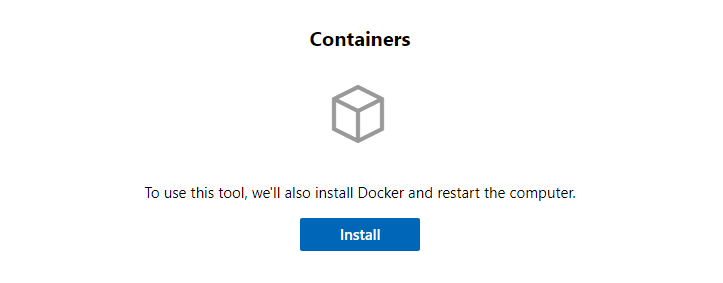Estimated reading time: 3 minutes
Docker Desktop for Mac is the Community version of Docker for Mac.You can download Docker Desktop for Mac from Docker Hub.

By downloading Docker Desktop, you agree to the terms of the Docker Software End User License Agreement and the Docker Data Processing Agreement.
System requirements
Cloud native images. Install GitLab with Docker. Docker and container technology have been revolutionizing the software world for the past few years. They combine the performance and efficiency of native execution with the abstraction, security, and immutability of virtualization. Install using Docker Compose. Use this information to quickly start up Community Edition using Docker Compose. Note: While Docker Compose is often used for production deployments, the Docker Compose file provided here is recommended for development and test environments only.
Your Mac must meet the following requirements to successfully install Docker Desktop:

macOS must be version 10.14 or newer. That is, Mojave, Catalina, or Big Sur. We recommend upgrading to the latest version of macOS.
If you experience any issues after upgrading your macOS to version 10.15, you must install the latest version of Docker Desktop to be compatible with this version of macOS.
Note
Docker supports Docker Desktop on the most recent versions of macOS. That is, the current release of macOS and the previous two releases. As new major versions of macOS are made generally available, Docker stops supporting the oldest version and supports the newest version of macOS (in addition to the previous two releases). Docker Desktop currently supports macOS Mojave, macOS Catalina, and macOS Big Sur.
At least 4 GB of RAM.
VirtualBox prior to version 4.3.30 must not be installed as it is not compatible with Docker Desktop.
- Docker Desktop for Windows includes Compose along with other Docker apps, so most Windows users do not need to install Compose separately. For install instructions, see Install Docker Desktop on Windows. If you are running the Docker daemon and client directly on Microsoft Windows Server, follow the instructions in the Windows Server tab.
- Details about how to use Kong in Docker can be found on the DockerHub repository hosting the image: kong. We also have a Docker Compose template with built-in orchestration and scalability. With a Database. Here is a quick example showing how to connect a Kong container to a Cassandra or PostgreSQL container. Create a Docker network.
- Inside the Docker Image, openHAB is installed to /openhab. The install is a manual installation so all of the files are located here. This is also set as the home directory of the openhab user. The Image has a very minimal installation of Linux with no services running and just enough installed to allow openHAB to run. # Installation through Docker.
What’s included in the installer
The Docker Desktop installation includes Docker Engine, Docker CLI client, Docker Compose, Notary, Kubernetes, and Credential Helper.
Install and run Docker Desktop on Mac
Double-click
Docker.dmgto open the installer, then drag the Docker icon to the Applications folder.Double-click
Docker.appin the Applications folder to start Docker. (In the example below, the Applications folder is in “grid” view mode.)The Docker menu in the top status bar indicates that Docker Desktop is running, and accessible from a terminal.
If you’ve just installed the app, Docker Desktop launches the onboarding tutorial. The tutorial includes a simple exercise to build an example Docker image, run it as a container, push and save the image to Docker Hub.
Click the Docker menu () to seePreferences and other options.
Select About Docker to verify that you have the latest version.
Congratulations! You are now successfully running Docker Desktop.
If you would like to rerun the tutorial, go to the Docker Desktop menu and select Learn.
Automatic updates
Docs Docker Compose Install
Starting with Docker Desktop 3.0.0, updates to Docker Desktop will be available automatically as delta updates from the previous version.
When an update is available, Docker Desktop automatically downloads it to your machine and displays an icon to indicate the availability of a newer version. All you need to do now is to click Update and restart from the Docker menu. This installs the latest update and restarts Docker Desktop for the changes to take effect.
Uninstall Docker Desktop
Docker Doc Install
To uninstall Docker Desktop from your Mac:

- From the Docker menu, select Troubleshoot and then select Uninstall.
- Click Uninstall to confirm your selection.
Docker Docs Install Windows
Important
Uninstalling Docker Desktop destroys Docker containers, images, volumes, andother Docker related data local to the machine, and removes the files generatedby the application. Refer to the back up and restore datasection to learn how to preserve important data before uninstalling.

Docker Docs Install Linux
Where to go next
Http://docs.docker.com/engine/installation
- Getting started provides an overview of Docker Desktop on Mac, basic Docker command examples, how to get help or give feedback, and links to other topics about Docker Desktop on Mac.
- Troubleshooting describes common problems, workarounds, howto run and submit diagnostics, and submit issues.
- FAQs provide answers to frequently asked questions.
- Release notes lists component updates, new features, and improvements associated with Docker Desktop releases.
- Get started with Docker provides a general Docker tutorial.
- Back up and restore data provides instructionson backing up and restoring data related to Docker.
Docs Docker Install
mac, install, download, run, docker, local